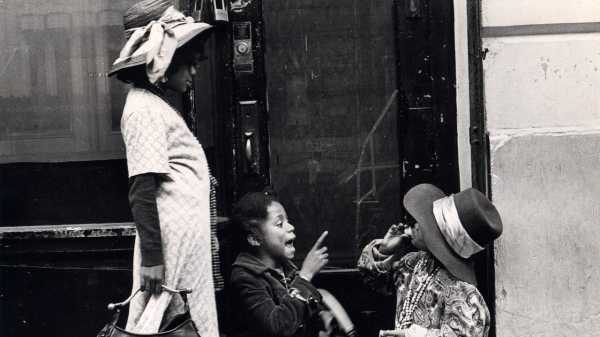
“A Dream Is What You Wake Up From,” a film by Larry Bullard and Carolyn Y. Johnson, from 1978, which screens tonight at BAM Cinématek, is a prime example of why repertory houses exist—to show extraordinary movies that are otherwise unavailable or largely undiscussed. The film is prescient in its passionate, analytical view of inequities regarding gender, race, and class. It’s also a forward-looking, boldly imaginative view of the journalistic power of the cinema itself, in documenting, acknowledging, and redressing these injustices. (It’s screening as part of the series “A Different Picture: Women Filmmakers in the New Hollywood Era, 1967–1980”; it’s also available to stream at the Internet Archive.)
“A Dream Is What You Wake Up From” is about black American women who are being oppressed and overwhelmed—physically beaten or emotionally beaten down—by black men, and it traces the modern pressures as well as the historical traumas that play out in African-American family life. It’s centered on the story of two New York families, the Flemings and the Franklins. The Flemings live in a Harlem housing project. The movie opens with Mrs. Fleming and a female friend talking at a kitchen table, as Mrs. Fleming discusses the beatings that she endures from her husband, which would make her “want to commit murder and suicide” if it weren’t for the couple’s young children. She considers leaving her husband and living on her own, but she knows that, if she were to get a full-time job, she’d still not be paid the same as a man.
The other family, the Franklins, have moved out of the city to a house in suburban New Jersey. They, too, have young children—they’re Barbara Franklin’s, from a previous marriage. Bill Franklin, their devoted and loving stepfather, is a successful insurance salesman and financial counsellor who works in New Jersey; Barbara works at an unspecified office job in New York, commuting by train. Bullard and Johnson film the couple sitting side by side at home. Barbara and Bill have an easy, jovial rapport, and Bill uninhibitedly voices his love and admiration for Barbara. They’re filmed around Christmas, and the house is joyful, the children’s presents are copious, and both their son and their daughter delight in riding their new bicycles around the calm, quiet neighborhood, which resounds with the bells on their handlebars as well as the chirping of birds. But Barbara is unhappy: she misses the city life. She has no friends in the suburbs, but many in the city; her commute is exhausting, beginning, on many days, before the children are awake and ending at night, after they’ve gone to sleep. Barbara only wants the family to move back to New York. Bill insists that they’ll do so—eventually—but that, for now, the children are happy and, above all, “safe.” Barbara challenges that idea, but, with good humor and warm devotion, Bill simply deflects, dismisses, and overrides her desires.
The movie is a documentary of sorts; an opening title card reads “Segments of this film are dramatized.” But a strange irony echoes from that admission, in the course of the film, because one sequence—about a small group of black laborers working in a tobacco field, later discussing their experiences from when they were enslaved, and then, by night, trying to flee their armed white field bosses—is obviously and conspicuously a piece of dramatized history, set in the post-Civil War South. What’s not clear is which other scenes from the hourlong film were written for or improvised by actors, and which are the recordings of people recounting and displaying their real-life experiences—and the credits, listing seven “professional actors” and six “non-professional actors,” don’t help. Which is to say, it doesn’t matter—what matters is that the ideas in the film aren’t fictional.
Bullard (who’s also the cinematographer) and Johnson compose these two families’ stories into an elaborate collage of powerfully analytical reflections on gendered oppressions. There’s a scene of a seminar—titled “The Black Family” and set in the auditorium of a Harlem library—in which speakers discuss expressly the political aspect of family life, including one woman who looks back at the civil-rights and black-power movements of the nineteen-sixties and says, “black women were told our position in the revolution was prone.” There’s a scene of the Flemings in family counselling, where Mrs. Fleming describes how her husband drinks, spends the family’s money on other women, comes home, beats her and the children, and “tries to force” her to have sex with him, and Mr. Fleming complains angrily that she “nags” him. The advice that the counsellors offer the couple is equally shocking, especially when one counsellor, a woman, suggests that Mrs. Fleming compromise and “not harass” her husband, in exchange for which he’ll agree to “stop assaulting” her. The historical sequence—filmed with a pictorial intensity that seems like a homage to Oscar Micheaux’s silent films—features a crucial moment of dialogue, in which one man describes the anguish of being separated from his wife at the auction block. “A Dream Is What You Wake Up From” suggests that the ongoing traumas and derangements in the relations between men and women in black American families are a bitter legacy of the sexual and emotional traumas of slavery and Jim Crow.
The movie leaps outside of itself in a remarkable series of scenes set inside an editing room, where four men watch footage of Mrs. Fleming and her friend talking about the abuse that she endures, and of the Flemings at their counselling session. The men express a wide range of opinions and ideas, ranging from the crudely judgmental to the insightfully reflective—including the recognition that “male chauvinist” attitudes are passed down from generation to generation. One man reflects on his father’s “cold and unemotional” behavior, a notion that’s echoed in Barbara Franklin’s remark that her own father was unemotional. If the generational heritage of male supremacy is to be broken, the movie suggests, education will play a major role—as in a scene at day care, where one of the Flemings’ children is taught in a classroom in which familiar gender roles are questioned and challenged. (Another child, chillingly, describes his drawing: “My mommy and my daddy are fighting, and my mommy is gonna get black and blue over here.”)
“A Dream Is What You Wake Up From” is a film of echoes and reverberations, of historical and societal phenomena reflected from generation to generation, both in the public realm and in private life. Mrs. Fleming’s friend at the kitchen table acknowledges that poor black men such as Mr. Fleming are likely demeaned at work by their white bosses, but “he’s not going to say that his pride has been stepped on by whitey,” so “he takes shit from the world, comes home, and hits you.” One man in the editing room admits that “we allow ourselves to be fucked over by our bosses,” and that the inability both to act and to speak on their own behalf is at the root of men’s lack of self-questioning. And yet, in a poem of Johnson’s that’s read, as part of the soundtrack, to introduce the Franklins’ suburban comforts, Johnson refers to “the dream of free love and store-bought struggle that this selling of ourselves offers as unrequited revolution’s reward”—personal gratifications and accomplishments that perpetuate other modes of oppression. Near the end of the film, Mrs. Fleming’s friend poses a simple and decisive question, one that remains, unhappily, as urgent now as it was in 1978: “Do you think that he can have you equal with him, not behind him?”
Sourse: newyorker.com






